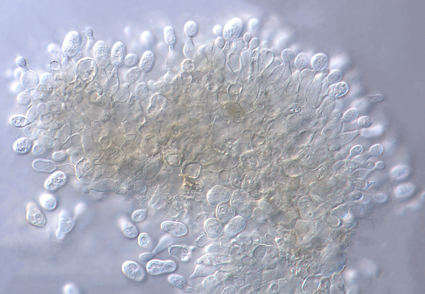Abstract
During a survey of microfungi on symptomatic leaves from Photinia serratifolia (Desfontaines) Kalkman, an interesting species of asexual ascomycetes were found. Based on multilocus phylogenies from a combined dataset of genes encoding internal transcribed spacer (ITS), large subunit of ribosomal RNA (LSU), translation elongation factor 1 alpha (tef1), part of the beta-tubulin gene region (tub2), and partial RNA polymerase II second largest subunit (rpb2), in conjunction with morphological characteristics, we describe a new genus of Tubakiaceae, Ellipsoidisporodochium gen. nov. (type species: Ellipsoidisporodochium photiniae sp. nov.). The genus has fusoid to ampulliform sporodochia and obovoid to ellipsoid conidia. Their relatedness to allied taxa are also annotated and discussed.
References
<p>Carbone, I. & Kohn, L.M. (1999) A method for designing primer sets for speciation studies in filamentous ascomycetes. <em>Mycologia</em> 91 (3): 553–556. https://doi.org/10.1080/00275514.1999.12061051</p>
<p>Fan, X.L., Bezerra, J.D.P., Tian, C.M. & Crous, P.W. (2018) Families and genera of diaporthalean fungi associated with canker and dieback of tree hosts. <em>Persoonia</em> 40: 119–134. https://doi.org/10.3767/persoonia.2018.40.05</p>
<p>Glass, N.L. & Donaldson, G.C. (1995) Development of primer sets designed for use with the PCR to amplify conserved genes from filamentous ascomycetes. <em>Applied and Environmental Microbiology</em> 61 (4): 1323–1330. https://doi.org/10.1128/AEM.61.4.1323-1330.1995</p>
<p>Gao, Y.H., Sun, W., Su, Y.Y. & Cai, L. (2014) Three new species of <em>Phomopsis</em> in Gutianshan Nature Reserve in China. <em>Mycological Progress</em> 13 (1): 111–121. https://doi.org/10.1007/s11557-013-0898-2</p>
<p>Guo, L.D., Hyde, K.D. & Liew, E.C.Y. (2000) Identification of endophytic fungi from <em>Livistona chinensis</em> based on morphology and rDNA sequences. <em>New Phytologist</em> 147 (3): 617–630. https://doi.org/10.1046/j.1469-8137.2000.00716.x</p>
<p>Huelsenbeck, J.P. & Ronquist, F. (2001) MRBAYES: Bayesian inference of phylogeny. <em>Bioinformatics</em> 17 (17): 754–755. https://doi.org/10.1093/bioinformatics/17.8.754</p>
<p>Katoh, K., Rozewicki, J. & Yamada, K.D. (2019) MAFFT online service: multiple sequence alignment, interactive sequence choice and visualization. <em>Briefings in Bioinformatics</em> 20: 1160–1166. https://doi.org/10.1093/bib/bbx108</p>
<p>Kumar, S., Stecher, G. & Tamura, K. (2016) MEGA7: Molecular Evolutionary Genetics Analysis Version 7.0 for Bigger Datasets. <em>Molecular Biology and Evolution</em> 33 (7): 1870–1874. https://doi.org/10.1093/molbev/msw054</p>
<p>Liu, Y.J., Whelen, S. & Hall, B.D. (1999) Phylogenetic Relationships among Ascomycetes: evidence from an RNA polymerse II subunit. <em>Molecular Biology and Evolution</em> 16 (12): 1799–1808. https://doi.org/10.1093/oxfordjournals.molbev.a026092</p>
<p>Miller, M.A., Pfeiffer, W. & Schwartz, T. (2012) The CIPRES science gateway: enabling high-impact science for phylogenetics researchers with limited resources.<em> In: Proceedings of the 1st Conference of the Extreme Science and Engineering Discovery Environment.</em> Bridging from the extreme to the campus and beyond. Association for Computing Machinery, USA, pp. 1–8. https://doi.org/10.1145/2335755.2335836</p>
<p>Nylander, J.A.A. (2004) MrModelTest v. 2. Program distributed by the author. Evolutionary Biology Centre, Uppsala University.</p>
<p>O’Donnell, K., Kistler, H.C., Cigelnik, E. & Ploetz, R.C. (1998) Multiple Evolutionary Origins of the Fungus Causing Panama Disease of Banana: Concordant Evidence from Nuclear and Mitochondrial Gene Genealogies. <em>Proceedings of the National Academy of Sciences of the United States of America</em> 95 (5): 2044–2049. https://doi.org/10.1073/pnas.95.5.2044</p>
<p>Rehner, S.A. & Samuels, G.J. (1994) Taxonomy and phylogeny of <em>Gliocladium</em> analysed from nuclear large subunit ribosomal DNA sequences. <em>Mycological Research</em> 98 (6): 625–634. https://doi.org/10.1016/S0953-7562(09)80409-7</p>
<p>Ronquist, F. & Huelsenbeck, J.P. (2003) MrBayes 3: Bayesian Phylogenetic Inference under Mixed Models. <em>Bioinformatics</em> 19 (12): 1572–1574. https://doi.org/10.1093/bioinformatics/btg180</p>
<p>Ronquist, F., Teslenko, M., van der Mark, P., Ayres, D.L., Darling, A., Höhna, S., Larget, B., Liu, L., Suchard, M.A. & Huelsenbeck, J.P. (2012) MrBayes 3.2: efficient Bayesian phylogenetic inference and model choice across a large model space. <em>Systematic Biology</em> 61 (3): 539–542. https://doi.org/10.1093/sysbio/sys029</p>
<p>Senanayake, I.C., Crous, P.W., Groenewald, J.Z., Maharachchikumbura, S.S.N., Jeewon, R., Phillips, A.J.L., Bhat, J.D., Perera, R.H., Li, Q.R., Li, W.J., Tangthirasunun, N., Norphanphoun, C., Karunarathna, S.C., Camporesi, E., Manawasighe, I.S., Al-Sadi, A.M. & Hyde, K.D. (2017) Families of Diaporthales based on morphological and phylogenetic evidence. <em>Studies in Mycology</em> 86: 217–296. https://doi.org/10.1016/j.simyco.2017.07.003</p>
<p>Stamatakis, A. (2014) RAxML Version 8: a tool for phylogenetic analysis and post-analysis of large phylogenies. <em>Bioinformatics</em> 30 (9): 1312–1313. https://doi.org/10.1093/bioinformatics/btu033</p>
<p>Sung, G.H., Sung, J.M., Hywel-Jones, N.L. & Spatafora, J.W. (2007) A multi-gene phylogeny of Clavicipitaceae (Ascomycota, Fungi): identification of localized incongruence using a combinational bootstrap approach. <em>Molecular Phylogenetics and Evolution</em> 44 (3): 1204–1223. https://doi.org/10.1016/J.YMPEV.2007.03.011</p>
<p>Vilgalys, R. & Hester, M. (1990) Rapid genetic identification and mapping of enzymatically amplified ribosomal DNA from several <em>Cryptococcus</em> species. <em>Journal of Bacteriology</em> 172 (8): 4238–4246. https://doi.org/10.1128/JB.172.8.4238-4246.1990</p>
<p>White, T.J., Bruns, T., Lee, S. & Taylor, J. (1990) Amplification and direct sequencing of fungal ribosomal RNA genes for phylogenetics. In: Innis, M.A., Gelfand, D.H., Sninsky, J.J. & White, T.J. (Eds.) <em>PCR Protocols: a guide to methods and applications. </em>Academic Press, San Diego, pp. 315–322. https://doi.org/10.1016/B978-0-12-372180-8.50042-1</p>
<p>Zhang, Z., Schwartz, S., Wagner, L. & Miller, W. (2000) A greedy algorithm for aligning DNA sequences. <em>Journal of Computational Biology</em> 7: 203–214. https://doi.org/10.1089/10665270050081478</p>
<p>Zhang, Z.X., Mu, T.C., Liu, S.B., Liu, R.Y., Zhang, X.G. & Xia, J.W. (2021) Morphological and phylogenetic analyses reveal a new genus and two new species of Tubakiaceae from China. <em>Mycokeys</em> 84: 185–201. https://doi.org/10.3897/mycokeys.84.73940</p>


